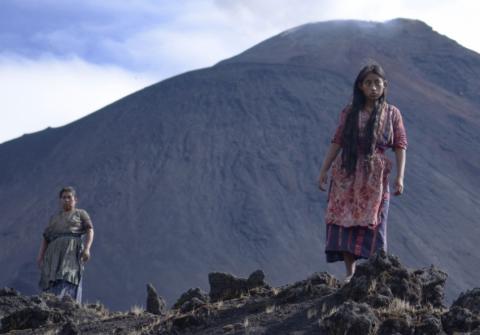Jayro Bustamante‘s debut feature “Ixcanul” generates its power from an intimate observance of the quotidian. As such, its titular volcano — the translation of Ixcanul in the Mayan K’iche’ dialect spoken in Guatemala — is the least volcanic thing in it. Steeped in a culture rarely observed on screen, Bustamante’s film has the airs of a documentary. Its ensemble cast of local actors have zero trace of affectation in their performances. The director’s original screenplay is beholden to none of the format’s rules that so often shackle stories with predictability. It’s as much of a striking initiation for cinematographer Luis Armando Arteaga as it is for Bustamante, for the film feels so confident with its movement, lighting, and composition. Its cast and crew may be young in terms of film experience, but “Ixcanul” is very much an old soul.
On the Guatemalan highlands overseen by the active Pacaya volcano rests a coffee planation, where 17-year-old Maria (Maria Mercedes Coroy) lives with her mother Juana (Maria Telon) and father Manuel (Manuel Manuel Antun). The parents are preparing her arranged marriage to businessman Ignacio (Justo Lorenzo), though the young girl dreams of escaping to the United States with her friend and pseudo-lover Pepe (Marvin Coroy). Demure and reticent, Maria doesn’t outrightly express her dissatisfaction with Guatemalan traditions and the preordained trajectory of a woman’s life within them, but the opening close-up says it all. Her expression, as she quietly lets her mother dress her up in wedding garments, is one of servile submission, and it’s got an instant sting about it. We’ve just met this girl, but we already don’t want this for her.
“Ixcanul” is suffused with indigenous customs in the form of homeopathic remedies, religious ceremonies, and local superstitions. Maria’s family has a spiritual guide who sits with them at the dinner table, and, like a concerned uncle, questions Ignacio’s intentions. People’s livelihoods are threatened not by some nameless corporation or the crushing hand of capitalism, but by an overabundance of snakes. And if all these cultural intricacies weren’t enough to permanently glue your attention to the screen (they should be), Maria’s story and everything she and her family go through is full of universal pangs. One wouldn’t think it at first, but there are plenty of villains and heroes here. Underneath its docu-like exterior lies a whispered coming-of-age fable, ending with a soft blow that’ll make your knees weak.
Imagine combining the subject of a Sensory Ethnography Lab project with the meditative nature of an Apichatpong Weerasethakul picture, and you’ll grab the gist of “Ixcanul.” Scenes that organically flow into one another, even when they overstay their welcome or end before their time is up, are delicately perceptive. The performers, if they can be called that, all immerse themselves, but it’s perhaps Maria Telon as Juana, the overprotective and concerned mother, who tears our heart into tiny pieces. A scene in the back of a truck will haunt me for months mostly thanks to Telon’s performance. Bustamante’s sense of framing is uncanny, considering this is his first full feature; the most mundane activities — picking fruit off of a tree, for example, or a conversation in the middle of the road — attain a sense of providence. The role Arteaga’s lighting plays in this is vital. A scene in the back of the bar, with Maria and a drunk Pepe, is as emblematic of this as anything else.
The film is ripe with symbolism. Nature’s venom is a foil to man’s poisonous manipulation of language barriers. Animals, vegetation, and the presence of the off-screen volcano, are as much a part and parcel to the story’s essence as the actions of Maria, Juana, Pepe, and Ignacio are. What lies behind the volcano? For some it’s the United States through Mexico, and opportunity for a better way of life. For others, it’s just cold weather. As “Ixcanul” glacially moves forward, we feel more and more invested with Maria’s place in the world. And as a result, the Guatemalan way of life feels even more illuminated. Hats off to Bustamante for using the exoticism of his titular volcano in the subtlest of ways, focusing instead on the humanity that courses through the veins of Guatemala’s Mayan community. While I don’t like to give much credence to industry awards, if there’s ever a film deserving of the attention that comes with being nominated, Guatemala’s first ever Academy Awards entry.
Bustamente's movie, was independently produced and won the Silver Bear at the Berlin Film Festival last year. The film is screening currently in NYC at the IFC Center.


Spread the word